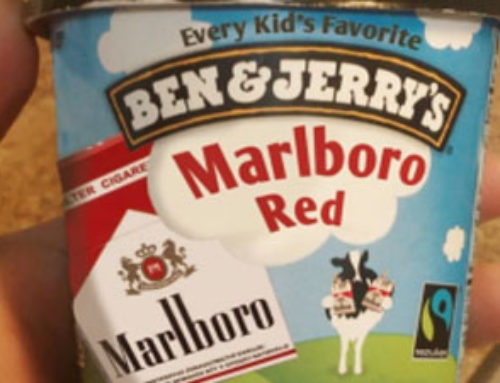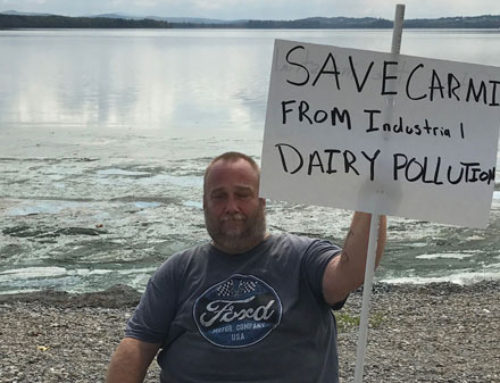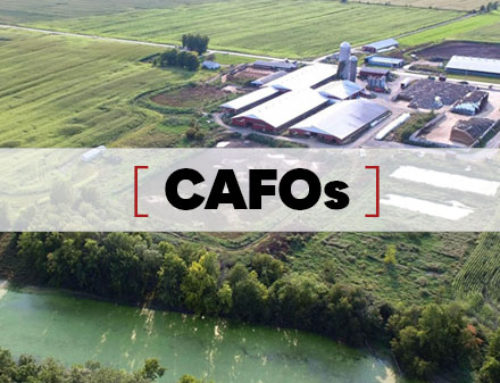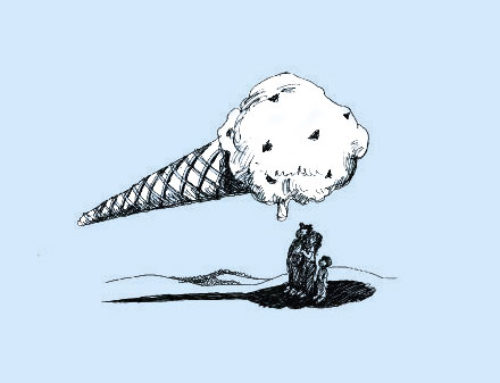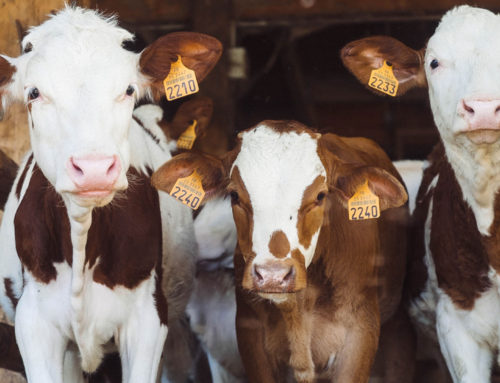Despite calls from health professionals worldwide to curb the use of farm-animal antibiotics, Vermont’s conventional dairy industry — dominated by concentrated animal feeding operations (CAFOs) – continues to use the antimicrobial drugs extensively, including non-therapeutic uses to prevent diseases caused by the animal confinement and concentration. After numerous records requests and analysis, including eight years of antibiotic violation data obtained from the Vermont Agency of Agriculture, Food and Markets (VAAFM), we found a rising trend with on-farm antibiotic violations, a lax regulatory environment, and no plan – or even goal – to address the problem.
Vermont’s nonorganic dairy industry is all but ignoring the dire warnings from the World Health Organization (WHO) to reduce overall antibiotic use in food production, a leading cause of antibiotic resistance, which makes the drugs less effective when necessary to combat human illnesses. While the WHO has called for a complete halt to using antibiotics as a prophylactic in food production– preventing rather than treating animal diseases — Vermont’s dairy industry, with the support of VAAFM regulators, continues to allow healthy cows to be routinely treated between lactations.
While all milk is tested for antibiotic residues, as each farm must provide a sample at the time of the pickup, the tests are based on tolerances, or allowable levels. It is understood that, given the widespread use of antibiotics on CAFO-style dairy farms, that some level of residues exist in the milk. The milk containing antibiotic residues above limits set by the Food & Drug Administration (FDA) is considered adulterated and is required to be dumped. If it’s below the limits, the milk is legal and processed.
In 2017, there were 18 reported violations of antibiotic residue limits in Vermont, each triggering a site visit and warning from the VAAFM. This was up from 10 such violations reported in 2014, but down from the highest year, 2010, when 32 violations were documented. While these are a fraction of the total milk loads shipped, that doesn’t correlate to low antibiotic usage. It simply means that dairy farmers understand the rules for use and detection, thus keeping within the allowable residue levels.
Included in these violations are what the VAAFM calls “routine” antibiotic test failures, in which above-the-limit, residue-contaminated milk from one farm gets diluted with milk from other farms along the same route, thus comingled into the same milk tanker. The blended milk will fall within legal residue limits, thus processed and introduced into the food supply.
The milk samples collected at each farm are not tested immediately unless the entire tanker tests positive before unloading at the milk buyer’s facility. The samples are all tested later within the buyer’s laboratory, primarily for butterfat and other milk components but also for drug residues. When illegal levels of residues are detected in the lab, the violation is categorized as a “routine positive” by VAAFM, and the farm in violation won’t be flagged and cited until well after the load has been processed.
In 2017, there were three “routine” positive loads of antibiotic-infected milk that were processed by St. Albans Cooperative Creamery, the exclusive supplier for Ben & Jerry’s ice cream. Agri-Mark, the owners and suppliers of Cabot Creamery’s dairy supply, processed at least one load in 2017 that contained violative levels of antibiotics from a farm.
These “routine” antibiotic test failures in Vermont’s dairy supply only prove what has been suspected all along: antibiotic residues are getting into the food supply. It’s not a matter of whether nonorganic dairy products like those produced by Ben & Jerry’s and Cabot Creamery contain antibiotic residues, but rather at what level.
The WHO, Centers for Disease Control (CDC), FDA, and every other major health regulator has called the overuse of agricultural antibiotics among the most serious threats to human health facing the world. The CDC estimates that “drug-resistant bacteria cause two million illnesses and approximately 23,000 deaths each year in the United States alone.” As a result, there is a unanimous call among health professionals demanding action, beginning with immediate and substantial reductions in the use of farm-animal antibiotics, which accounts for 80% of the total antibiotic usage in the U.S. In the words of the WHO, the human health threat from antimicrobial resistance caused by antibiotic overuse in the agricultural sector is “an increasingly serious threat to global public health that requires action across all government sectors and society.”
In Vermont, the government regulator on the frontlines of agricultural antibiotics use and regulation is the office of VAAFM’s State Veterinarian, Dr. Kristin Haas. Oddly enough, she also carries the title of “Director of Food Safety & Consumer Protection,” and it’s Haas’ office that oversees the rules, regulations and enforcement of all agricultural antibiotics. If Vermont’s agricultural sector were to do its part in responding to the dire warnings from health advocates to substantially reduce antibiotic use on the state’s dairy farms, it would be Dr. Haas who would lead such efforts.
Alarmingly, when asked in an official public records request submitted by Regeneration Vermont seeking information about the VAAFM’s efforts and programs to answer the urgent calls to reduce antibiotic use, Dr. Haas responded with the following: “There is not a program in place with the goal of reducing antibiotic use on dairy farms.”
Furthermore, when Regeneration Vermont asked Dr. Haas for records on overall antibiotic usage and trends in the state, she responded – in writing – with this: “The Agency does not monitor antibiotic purchases and sales or maintain records that quantify this data. As such, we do not have records responsive to this request.”
While the National Action Plan for Combating Antibiotic-Resistant Bacteria, coordinated by the U.S. Department of Health and Human Services, calls for an all-hands-on-deck approach to reducing agricultural use of antibiotics, Vermont’s chief regulator of such matters seemingly shrugs it all off by declaring that “the reduction of farm animal antibiotics is not a goal of the Agency.”
It’s yet another example of the conflicted, dual roles of the VAAFM, as both promoter and police of the CAFO-dominated dairy industry. On one hand they’re a cheerleader for all things dairy, turning a blind eye to so many of its health and environmental problems, and on the other hand they’re supposed to be the watchdog and enforcer of farm rules and regulations. Having the state veterinarian in charge of food safety and consumer protection should set off all kinds of bells and whistles.
A review of the VAAFM’s antibiotic violations data indicates that most of the infractions are a result of the preventative — or routine – uses of antibiotics on dairy farms, as opposed to treating a sick cow. This prophylactic practice is a primary target of health advocates looking to curb the threat of drug-resistance issues that impacts millions of U.S. medical patients annually, killing tens of thousands. The U.S. Department of Agriculture (USDA) estimates that over 90% of CAFO-style dairy farms administer antibiotics to cows entering a nonlactating, or dry, period, sick or not. This is seen as “necessary” largely because of the concentrated and confined nature of these CAFO farms, which breeds and spreads pathogens and infections.
These “dry cows” being infused with preventative antibiotics between lactations are the cause for most of the antibiotic violations reported in Vermont. If not properly segregated from the milking herd, these cows slip back into the production line, contaminating the farm’s bulk tank.
Regeneration Vermont obtained the “Drug Residue Follow-up Inspection Reports” for each of the more than 150 violations since 2010. These reports are required to be filed by a VAAFM inspector and include an attempt to identify a “probable cause” for the violation. But many simply report “don’t know” or “not sure,” and literally leave it at that, highlighting the Agency’s “look away” nature to it all. The reports also included these “causes” for the violations: “producers son thinks Mexicans mistakenly milked a treated cow,” “Mexicans realized she had been milked by mistake but never said anything to producer,” and “had a treated cow and she was tagged but tag was covered with manure.”
One thing is clear after analyzing the state’s programs and data, Vermont is contributing to – not addressing or solving – the very serious antibiotic resistance problem. The residues are ending up in our dairy supply, meat supply (nearly a quarter of the meat supply is currently dairy-cow derived), and spread via the manure on our cropland, the gateways to our water resources. It’s only made worse by a conflicted regulatory framework within the VAAFM that routinely allows its dairy promotional role to supersede and otherwise impair its enforcement and public protection responsibilities.
But it’s time for Vermont to get serious about its contributions to the antibiotic residue problem. Because while Vermont has no plan or goal, health organizations like the WHO, CDC, American Medical Association, American Public Health Association, and the Infectious Disease Society of America are declaring an emergency, calling for immediate and significant reductions in the use of antibiotics for animal food production.
— Michael Colby
[Originally published in VTDigger]
